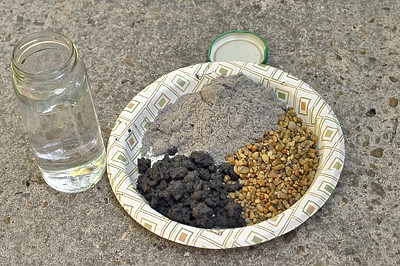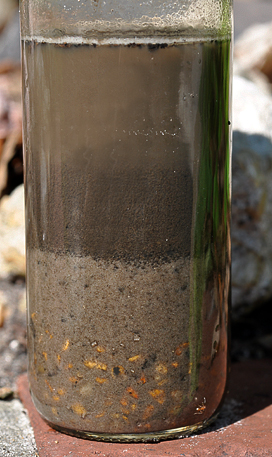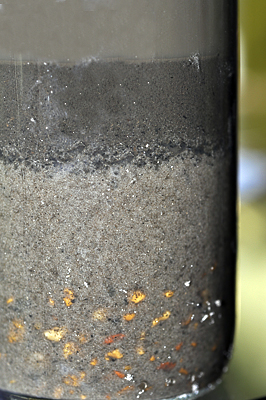
One of the main things that we use for identifying clastic sedimentary rocks is grain size, the size of the pieces. Rocks that have been deposited by water or wind tend to be very well sorted, with all of the pieces being pretty much the same size. How does that happen?
To find out, you will need:
- a glass jar with a lid
- water
- gravel
- sand
- clay or fine dirt

I used gravel from an old aquarium, but you could also use pebbles from a stream or even gravel from the side of a road. My sand came from the beach, but you can also find sand at garden supply stores, in playground sandboxes, and in streams. My clay came from our garden, but you can use dirt from your yard or potting soil.
Start by filling the jar about half full of water. Add a couple of hands full of sand. Then add some of the clay or dirt, followed by a layer of gravel. You can add some more sand and some more clay if you want. The more you mix the different sized sediments, the better. By the time you finish adding sediment, the jar should be nearly full.

Put the top on the jar, and give it a good shake. Remember that there is gravel in the jar, so don't shake it hard enough to break the glass. You want to be sure that the sediment and water are well mixed. Then swirl the jar for a moment to get the water moving round and round inside the jar. Place the jar on a table, and observe it carefully for the next few minutes.
You should notice that the gravel settles to the bottom almost instantly. Why? The pieces are heavier. The moving water pushes on all of the particles. If the water is moving fast enough, the particles will keep moving. As the water slows down, the heavier particles fall to the bottom. As the water continues to slow down, the sand will settle out next, followed by the clay. You will probably find that the smallest particles of clay will stay suspended in the water for a day or more before they settle to the bottom.

Now lets apply what we have seen to the real world. Imagine a beautiful, mountain stream. The water is flowing quickly, splashing and swirling along. What would the bottom of that stream look like? Do you think it would have a mud bottom? No. The water is moving too fast to deposit mud, or even sand. The bottom of that mountain stream would be mostly rocks. All of the smaller sediments would be carried on down stream.
If we follow that stream down out of the mountains, we will find that as the slope decreases, it slows down. Now we start to see sand, mud, and gravel, but they are not all mixed together. In places where the water flows quickly, the bottom will be mostly rock and gravel. In places where the water slows a bit, you will find sand deposits, and in places where the water moves very slowly, you will get deposits of silt and mud. Fine clay is usually deposited in places where the water is sitting still, such as lakes and swamps.
Looking at the beach, we see something similar. Beaches that are pounded by waves tend to be mostly rock. The rushing waves carry away the smaller bits. As the waves rush up onto the shore, they slow down, dropping sand or small gravel, depending on their speed. Off shore, where the water is not moving as much, fine sediments settle to the bottom to form the silty mud that the divers on nature shows always seem to stir up at some point.
You can apply the same information to help figure out the ancient environments that deposited sedimentary rocks. Deposits of sand can become sandstone. Deposits of clay and silt can become shale. This tells you something about the water speed when they formed.
